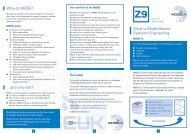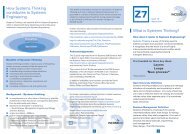Systems Engineering Competency Framework - INCOSE UK Chapter
Systems Engineering Competency Framework - INCOSE UK Chapter
Systems Engineering Competency Framework - INCOSE UK Chapter
Create successful ePaper yourself
Turn your PDF publications into a flip-book with our unique Google optimized e-Paper software.
<strong>Systems</strong> <strong>Engineering</strong><br />
<strong>Competency</strong> <strong>Framework</strong><br />
Using the <strong>Framework</strong>:<br />
The <strong>Systems</strong> <strong>Engineering</strong> competency<br />
framework is generic in purpose. It can, and<br />
indeed should, be tailored before use. It can<br />
be applied in the context of an organisation,<br />
a project, an individual and/or a training<br />
programme.<br />
The <strong>Framework</strong> describes the competencies<br />
of <strong>Systems</strong> <strong>Engineering</strong> rather than the<br />
competencies of an individual <strong>Systems</strong> Engineer.<br />
It is acknowledged that a well rounded systems<br />
engineer will need other competencies,<br />
knowledge, skills and abilities tailored to their<br />
particular role or area in which they operate.<br />
Many organisations have tailored the<br />
framework and are actively using it to:<br />
■ Identify individual’s and the organisation’s<br />
competencies in <strong>Systems</strong> <strong>Engineering</strong><br />
■ Identify learning and development opportunities<br />
■ Standardise job roles and descriptions<br />
■ Aid recruitment and direct interview questions<br />
■ Develop <strong>Systems</strong> <strong>Engineering</strong> training<br />
programmes<br />
Evaluation:<br />
A Guide to <strong>Competency</strong> Evaluation is also<br />
available and is designed as a companion to the<br />
<strong>Systems</strong> <strong>Engineering</strong> Competencies <strong>Framework</strong><br />
document. It gives guidance on how to evaluate<br />
people against the competency framework.<br />
What are the Competencies?<br />
■ <strong>Systems</strong> Thinking<br />
<strong>Systems</strong> concepts<br />
Super-system capability issues<br />
Enterprise and technology environment<br />
■ Holistic Lifecycle view<br />
Determine and manage stakeholder requirements<br />
System design:<br />
■ Architectural design<br />
■ Concept generation<br />
■ Design for…<br />
■ Functional analysis<br />
■ Interface management<br />
■ Maintaining design integrity<br />
■ Modelling and simulation<br />
■ Select preferred solution<br />
■ System robustness<br />
Integration & Verification<br />
Validation<br />
Transition to operation<br />
■ <strong>Systems</strong> <strong>Engineering</strong> Management<br />
Concurrent engineering<br />
Enterprise integration<br />
Integration of specialisms<br />
Lifecycle process definition<br />
Planning, monitoring and controlling<br />
For more information visit:<br />
http://www.incoseonline.org.uk<br />
Leaflet prepared and published by the <strong>UK</strong> <strong>Chapter</strong> of<br />
the International Council on <strong>Systems</strong> <strong>Engineering</strong>.<br />
With contributions from Sandra Hudson (lead author)<br />
of General Dynamics United Kingdom Limited and the<br />
<strong>INCOSE</strong> <strong>UK</strong> SE Competencies Working Group<br />
All queries should be addressed to the series editor<br />
Hazel Woodcock email: hazel.woodcock@uk.ibm.com<br />
© 2010: <strong>UK</strong> <strong>Chapter</strong>, International Council<br />
<strong>INCOSE</strong><strong>UK</strong><br />
on <strong>Systems</strong> <strong>Engineering</strong><br />
Z6 Issue 1.0 March 2010<br />
<strong>INCOSE</strong><strong>UK</strong><br />
Z6<br />
Issue<br />
1.0<br />
March 2010<br />
<strong>Systems</strong> <strong>Engineering</strong><br />
<strong>Competency</strong> <strong>Framework</strong><br />
<strong>INCOSE</strong><strong>UK</strong><br />
The <strong>Systems</strong> <strong>Engineering</strong> <strong>Competency</strong><br />
<strong>Framework</strong> was developed ‘to have a<br />
measurable set of competencies for <strong>Systems</strong><br />
<strong>Engineering</strong> which will achieve national<br />
recognition and will be useful to the enterprises<br />
represented by the <strong>INCOSE</strong> <strong>UK</strong><br />
Advisory Board’.<br />
It provides a common language with which to<br />
describe and discuss the competencies that are<br />
required to conduct good <strong>Systems</strong> <strong>Engineering</strong>.<br />
Does your organisation know what<br />
makes a good systems engineer?<br />
The <strong>Competency</strong> <strong>Framework</strong> can help!<br />
What are the Competencies based on?<br />
The <strong>Systems</strong> <strong>Engineering</strong> Competencies<br />
developed are consistent with the following:<br />
■ International Standards Organisation ISO15288<br />
■ EIA632<br />
■ <strong>INCOSE</strong> <strong>Systems</strong> <strong>Engineering</strong> Body of<br />
Knowledge & Handbook
Description<br />
Explains what the<br />
competency is and<br />
provides meaning<br />
behind the title.<br />
Why it matters<br />
indicates the importance<br />
of the competency and<br />
the problems that may<br />
be encountered in the<br />
absence of that<br />
competency<br />
COMPETENCY AREA - <strong>Systems</strong> Thinking: System Concepts<br />
Description:<br />
The application of the fundamental concepts of systems engineering. These include understanding what a system is, its context within its<br />
environment,its boundaries and interfaces and that it has a lifecycle.<br />
Why it matters:<br />
<strong>Systems</strong> Thinking is a way of dealing with increasing complexity. The fundamental concepts of <strong>Systems</strong> Thinking involves understanding how<br />
actionsand decisions in one area affect another, and that the optimisation of a system within its enviroment does not necessarily come from<br />
optimising the individual system components.<br />
Awareness<br />
The person is able to<br />
understand the key<br />
issues and their<br />
implications. They are<br />
able to ask relevant and<br />
constructive questions<br />
on the subject. This level<br />
is aimed at enterprise<br />
roles that interface with<br />
<strong>Systems</strong> <strong>Engineering</strong><br />
and therefore require an<br />
understanding of the<br />
<strong>Systems</strong> <strong>Engineering</strong><br />
role within the enterprise.<br />
Supervised Practitioner<br />
The person displays an<br />
understanding of the<br />
subject but requires<br />
guidance and supervision.<br />
This level defines those<br />
engineers who are<br />
“in-training” or are<br />
inexperienced in that<br />
particular competence.<br />
EFFECTIVE INDICATORS OF KNOWLEDGE AND EXPERIENCE<br />
AWARENESS SUPERVISED PRACTITIONER PRACTITIONER EXPERT<br />
Is aware of the need for systems<br />
concepts<br />
Aware of the importance of:<br />
■ system lifecycle<br />
■ hierarchy of systems<br />
■ system context<br />
■ interfaces<br />
■ interactions amongst<br />
systems and their elements<br />
Understands systems concepts<br />
Understands the system lifecycle<br />
in which they are working<br />
Understands system hierarchy<br />
and the principles of system<br />
partitioningin order to help<br />
manage complexity<br />
Understands the concept of<br />
emergent properties<br />
Can identify system boundaries<br />
andunderstands the need to<br />
define andmanage the interfaces<br />
Understands how humans and<br />
systems interact and how<br />
humanscan be elements<br />
of systems<br />
Able to identify and manage<br />
complexity with appropriate<br />
techniques in order to<br />
reduce risk<br />
Able to predict resultant<br />
system behavior<br />
Able to define system<br />
boundaries and external<br />
interfaces<br />
Able to assess the interaction<br />
between humans and systems,<br />
and systems and systems.<br />
Able to guide supervised<br />
practitioner<br />
Able to review and judge the<br />
suitability of systems solutions<br />
and the planned approach<br />
Has coached new practitioners<br />
in this field<br />
Has championed the<br />
introductionof novel techniques<br />
and ideas in this field which<br />
produced measurable<br />
improvements<br />
Has contributed to best practice<br />
Expert<br />
The person displays<br />
extensive and<br />
substantial practical<br />
experience and applied<br />
knowledge of<br />
the subject.<br />
Practitioner<br />
The person displays<br />
detailed knowledge of<br />
the subject and is capable<br />
of providing guidance<br />
and advice to others.<br />
<strong>INCOSE</strong><strong>UK</strong><br />
Figure 1 - Typical table extracted from the competency framework<br />
<strong>INCOSE</strong><strong>UK</strong><br />
© 2010: <strong>UK</strong> <strong>Chapter</strong>, International Council on <strong>Systems</strong> <strong>Engineering</strong>










